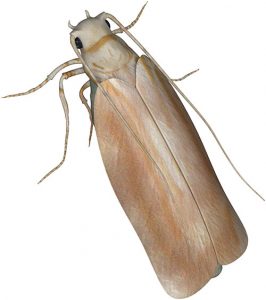Moth
Clothes Moth
 Adult, case making clothes moths are approximately 3/8 to ½ inch from wing tip to wing tip. The wings and body are buff to golden with a brown tinge, and the front wings have three dark spots. However, these distinguishing characteristics are often rubbed off. The larvae are small caterpillars, 3/8 inch long in size, that live within a small portable, silken case. The larvae have dark head capsules and the first thoracic segment is dark brown or black. The larvae carry their silken case wherever they go. The larvae, with its silken case, are camouflaged with bits of material on which the larva has been feeding. The larvae avoid light.
Adult, case making clothes moths are approximately 3/8 to ½ inch from wing tip to wing tip. The wings and body are buff to golden with a brown tinge, and the front wings have three dark spots. However, these distinguishing characteristics are often rubbed off. The larvae are small caterpillars, 3/8 inch long in size, that live within a small portable, silken case. The larvae have dark head capsules and the first thoracic segment is dark brown or black. The larvae carry their silken case wherever they go. The larvae, with its silken case, are camouflaged with bits of material on which the larva has been feeding. The larvae avoid light.
Adult moths are poor fliers, and avoid light. Clothes moths tend to prefer products from animal origins as well as products of plant origin. Some materials they can cause damage to but are not limited to are: woolens, rugs, feathers, skins, drugs, furs and stored tobacco.
Family
Lepidoptera/Tineidae
Scientific Name
Tinea Pellionella
Biology
Female clothes moths begin laying eggs (37-48) singly on suitable larval food the day after emerging as an adult. The larva feed for about 33-90 days and moults 5-11 times.The insect then pupates within the silken larval case. Development time from egg to adult requires 46-116 days. Adults may lay eggs year round in northern areas, but have only one generation per year.
Behaviour
The clothes moths prefer products of animal origin, secondarily feeding on products of plant origin. It is a pest of woollens, rugs, feathers, felts, skins, drugs, furs, and stored tobacco. Case making clothes moths shun light, and although the males are active fliers, the females fly only short distances.
Control & Prevention
The key to controlling this pest is through thorough inspection and identification of infested materials. Infested rugs, carpets, and furniture should be cleaned thoroughly and protected with a residual insecticide application. Larvae are easily removed from infested clothing by cleaning or laundering.
Conduct a regular inspection of all susceptible items at least once a year. Be sure to take all items out of closets and drawers, and vacuum thoroughly to remove all lint on which larvae may feed. Thoroughly clean clothing before putting it into storage. Clothes moths are drawn to articles soiled by food, beverages, urine, and perspiration, rather than clean garments. For furs, professional cleaning and cold storage is recommended. Any bird’s nests that may be close to the home including those of pigeons, starlings, and sparrows, should be removed.
Need help with moth extermination?
Call Nikol Pest Control at 604-364-3201 for a free estimate.

